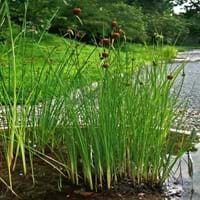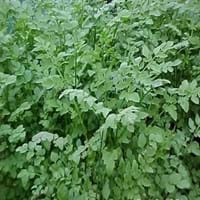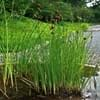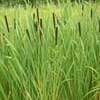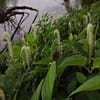Life Span
Perennial
Perennial
Type
Aquatics
Tender Perennial
Origin
Eastern Europe, Western Asia
Southern Asia, Southeastern Asia, India, China, Japan, Australia
Types
Common Cattail, Southern Cattail, Dwarf Bulrush
Not Available
Habitat
Lake margins, Ponds, Swamps
Bog Garden, Cultivated Beds, Ponds
USDA Hardiness Zone
3-11
9-11
AHS Heat Zone
12-1
Not Available
Sunset Zone
21,22
H1, 9, 14, 15, 16, 17, 18, 19, 20, 21, 22, 23, 24
Habit
Upright/Erect
Spreading
Flower Color
Yellow, Green, Brown, Chocolate
White
Flower Color Modifier
Not Available
Bicolor
Fruit Color
Light brown, Light Red
Not Available
Leaf Color in Spring
Green, Dark Green
Green
Leaf Color in Summer
Green, Dark Green
Green
Leaf Color in Fall
Green, Dark Green
Green
Leaf Color in Winter
Brown
Light Green
Leaf Shape
Long linear and narrow
simple-pinnate or double-pinnate
Plant Season
Summer, Fall, Winter
Summer, Fall
Sunlight
Full Sun, Partial Sun
Full Sun, Partial Sun, Partial shade
Type of Soil
Clay, Loam, Sand
Clay, Loam, Sand
The pH of Soil
Acidic, Neutral
Acidic, Neutral, Alkaline
Soil Drainage
Poorly Drained
Poorly Drained
Bloom Time
Summer, Late Summer, Early Fall
Late Summer, Early Fall
Tolerances
Wet Site
Drought
Where to Plant?
Container, In Water
Ground
How to Plant?
Runners
Divison, Layering, Seedlings, stem tip cuttings
Plant Maintenance
Low
Medium
Watering Requirements
Plant grows in water
Needs Very high moisture
In Summer
Aquatic Plant
Lots of watering
In Spring
Aquatic Plant
Moderate
In Winter
Aquatic Plant
Average Water
Soil pH
Acidic, Neutral
Acidic, Neutral, Alkaline
Soil Type
Clay, Loam, Sand
Clay, Loam, Sand
Soil Drainage Capacity
Poorly Drained
Poorly Drained
Sun Exposure
Full Sun, Partial Sun
Full Sun, Partial Sun, Partial shade
Pruning
Prune in early spring, Remove damaged leaves, Remove dead branches, Remove dead leaves
Remove dead leaves
Fertilizers
Nitrogen, Phosphate
Apply 10-10-10 amount
Pests and Diseases
Red blotch
Aphids, Armyworm, Bacterial Blight, Damping off, Downy mildew
Plant Tolerance
Drought
Drought
Flower Petal Number
Single
Single
Fragrant Flower
No
Not Available
Fragrant Leaf
No
Not Available
Fragrant Bark/Stem
No
Not Available
Foliage Texture
Medium
Fine
Foliage Sheen
Matte
Matte
Attracts
Birds, Flying insects
Bees, Flies, Insects
Allergy
Not Available
Not Available
Aesthetic Uses
Beautification, Showy Purposes, Water gardening
Bog Garden, Ground Cover
Beauty Benefits
Not Available
Not Available
Environmental Uses
Food for animals, Food for birds, Food for insects, Nesting sites for birds
Air purification
Medicinal Uses
Nutrients
Depurative, Febrifuge, Styptic
Part of Plant Used
Leaves
Leaves, Root, Seeds
Other Uses
Decoration Purposes, Showy Purposes, Used as Ornamental plant
Used as a seasoning in soups, useful as a ground cover
Used As Indoor Plant
Yes
No
Used As Outdoor Plant
Yes
Yes
Garden Design
Bog Garden, Container, Water Gardens
Container, Edible, Groundcover, Herb / Vegetable, Water Gardens
Botanical Name
TYPHA minima
OENANTHE javanica
Common Name
Dwarf Cattail
Java Water Dropwort, Water Celery, Water Parsley
In Hindi
बौना कैटेल
Water Celery
In German
Dwarf Rohrkolben
Wasser Sellerie
In French
Cattail nain
Céleri d'eau
In Spanish
Espadaña enano
El apio agua
In Greek
Νάνος Cattail
Σέλινο νερό
In Portuguese
Tifa Dwarf
Aipo água
In Polish
Dwarf Ożypałka
Seler Woda
In Latin
Pumilio Cattail
Aqua Apium
Phylum
Tracheophyta
Magnoliophyta
Class
Liliopsida
Magnoliopsida
Family
Typhaceae
Apiaceae
Clade
Angiosperms, Commelinids, Monocots
Angiosperms, Asterids, Eudicots
Tribe
Not Available
Oenantheae
Subfamily
Not Available
Apioideae
Number of Species
Not Available
Importance of Dwarf Cattail and Water Celery
Want to have the most appropriate plant for your garden? You might want to know the importance of Dwarf Cattail and Water Celery. Basically, these two plants vary in many aspects. Compare Dwarf Cattail and Water Celery as they differ in many characteristics such as their life, care, benefits, facts, etc. Every gardener must at least have the slightest clue about the plants he wants to plant in his garden. Compare their benefits, which differ in many ways like facts and uses. The medicinal use of Dwarf Cattail is Nutrients whereas of Water Celery is Depurative, Febrifuge and Styptic. Dwarf Cattail has beauty benefits as follows: Not Available while Water Celery has beauty benefits as follows: Not Available.
Compare Facts of Dwarf Cattail vs Water Celery
How to choose the best garden plant for your garden depending upon its facts? Here garden plant comparison will help you to solve this query. Compare the facts of Dwarf Cattail vs Water Celery and know which one to choose. As garden plants have benefits and other uses, allergy is also a major drawback of plants for some people. Allergic reactions of Dwarf Cattail are Not Available whereas of Water Celery have Not Available respectively. Having a fruit bearing plant in your garden can be a plus point of your garden. Dwarf Cattail has no showy fruits and Water Celery has no showy fruits. Also Dwarf Cattail is not flowering and Water Celery is not flowering . You can compare Dwarf Cattail and Water Celery facts and facts of other plants too.
